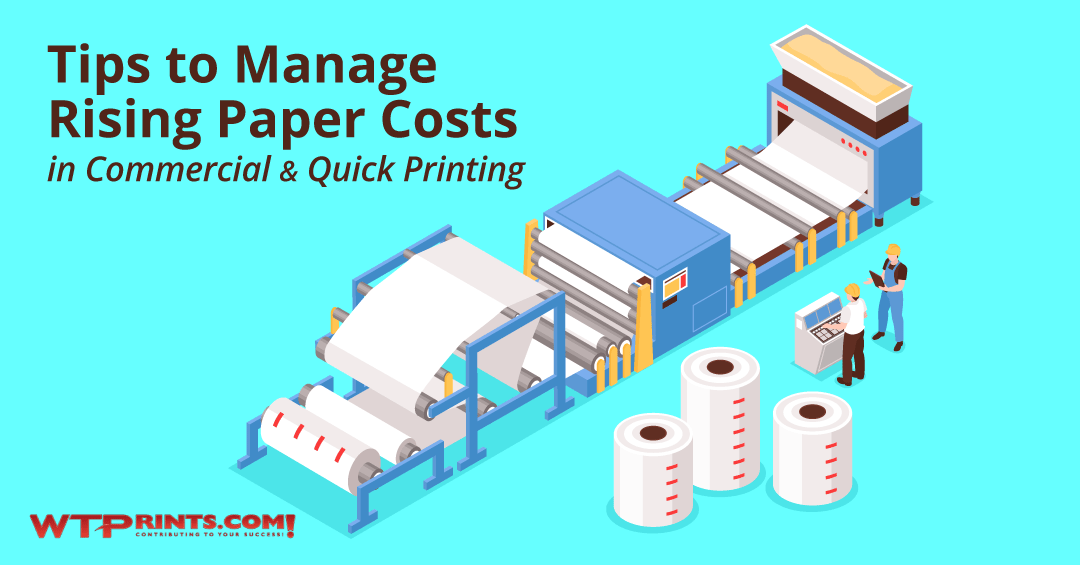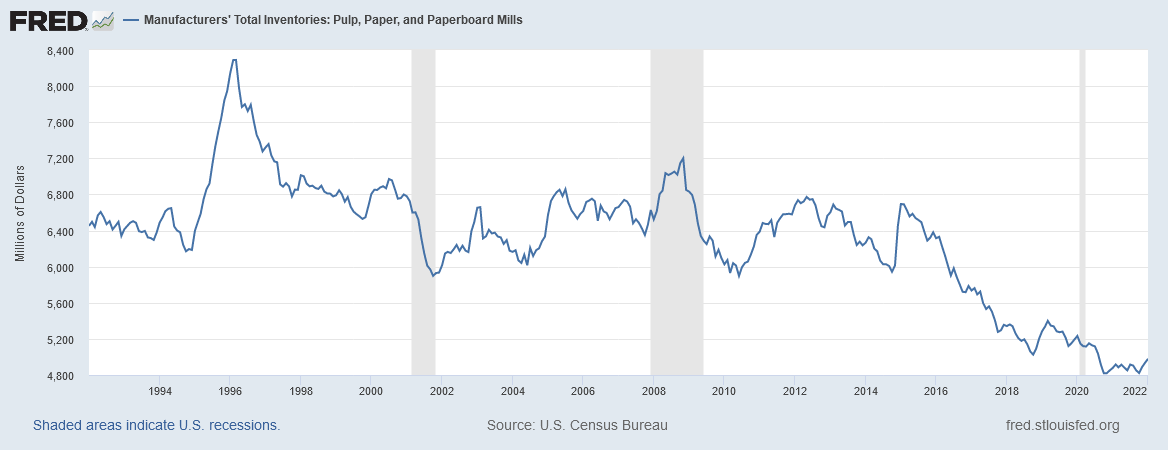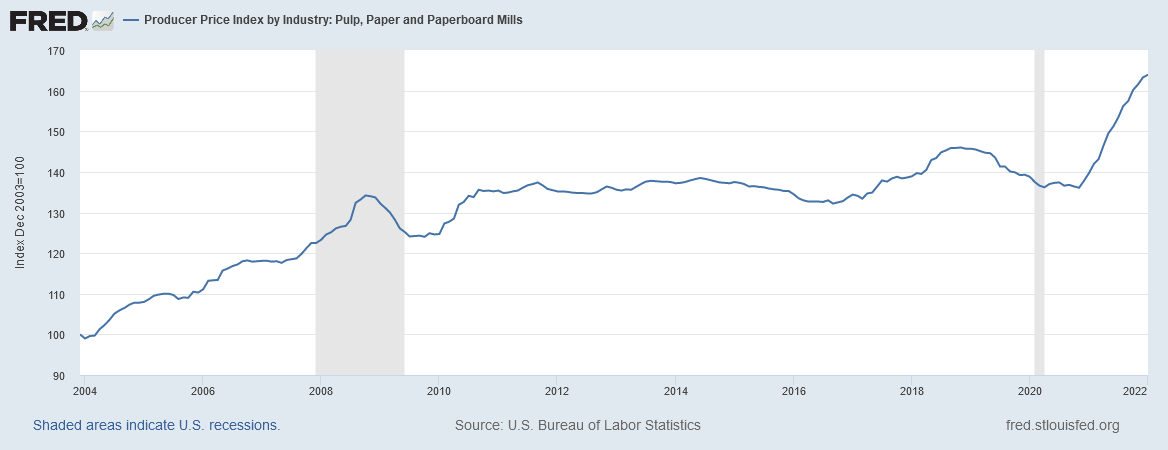The relentless rise in paper costs and print industry supply costs is not just another cycle to endure. We’ve had plenty of ups and downs over the decades. We got used to waiting them out.
This is not one of those times.
Current price increases, combined with logistical problems, are forcing us to change decades-old methods of working with clients.
Customs and practices that printers and their clients used to take for granted, could be the very things that put them out of business.
I’ll explain.
From our vantage point as a vendor to hundreds of printing companies and print brokers, we see what’s working and not working on the front lines and behind the scenes.
The best strategy for handling these paper cost increases and logistical issues, is to be pro-active in partnership with clients.
Here is a bit of background along with steps to take.
Factors in Rising Paper Price Costs

Here’s a summary of factors influencing the price of paper.
➤ Post-covid demand for printing paper increased because of a boom in ecommerce.
➤ Meanwhile, mills are eliminating and/or reducing total printing paper offerings. The trend continues down, as shown in the first chart below.
➤ Mills have been switching to more profitable paperboard and packaging material.
➤ Paper distributor inventories are low. Covid labor shortages and mill shutdowns were a factor.
➤ Prices are rising in pulp, labor, transportation, and chemicals. These all add to paper production and delivery costs.
The net effect is a big jump in recent paper prices (second chart below.)

Graph of drastic decline in paper inventories through early 2022 (St. Louis Fed Paper Inventories)

Graph of producer price index for paper through early 2022 (St. Louis Fed Paper Price Index)
The Mathematics of Paper Price Costs Rising
Clients might need a bit of education to cope with rising paper costs. To do that, it helps to demonstrate the ripple effect of even the smallest increases.
Example of the Effect of a Paper Price Increase
Note: this simplified example reflects ONLY a change in paper.
A typical $20,000.00 booklet order is about 45% paper. Paper cost on such a job WAS $9000.00.
Today’s paper cost is $13,500 (an increase of $4,500.)
That means today’s order, using the same margin, should be priced at $30,000.
Now factor in other material and labor costs:
- Ink and Coating up 15-20%
- Blankets up 40%
- Press Wash up 30 – 40%
- Fountain solution up 25% +
- Plates up 15%
- Labor up 10% or more
Let’s combine all these increases – this time without maintaining our margins. We’ll only pass along the added costs with our normal markups.
$20,000.00 booklet order original cost
+ $4500 extra paper cost
+ $1,000 extra labor and material costs
$25,550 cost to you
That’s a 27.7% increase to you. Now you must pass this along to your client. Let’s say you re-sell this job at a 30% margin.
$20,000 @ 30% margin = $28,571 retail
$25,550 @ 30% margin = $36,500 retail
Your client will pay $7,929 more, a 27.8% increase.
Let clients know what's going on behind the scenes, through the entire supply chain.
Then show them where their prices should be, based on conventional profit margin wisdom.
How to Manage Paper Price Increases
Here are six things we are doing to manage the paper pricing and supply crisis.
1 - Short-Run Digital Printing
Because smaller jobs need more labor than materials, they are affected less by paper costs than larger jobs.
This means that short-run digital jobs are less sensitive to daily price fluctuations. If you can steer your clients to more frequent short-run jobs, pricing is more stable.
They’ll pay more per unit but will be able to budget more accurately.
The added benefit is that their print collateral can be more frequently updated.
2 - Frequent Communication About Paper Status
On our end, we are in daily contact with all our paper suppliers, logistics companies and other vendors.
We discuss pricing and availability. We order popular stocks for our inventory as soon as they become available.
We advise clients when there may be shipping issues or when better logistical alternatives pop up.
On your end, it helps to communicate frequently and to be transparent about paper supply issues, pricing, and logistics and shipping delays. Be sure to include suggested solutions to the problems they are facing.
3 - Flexibility on Paper Selection
Encourage clients to be receptive to alternate papers. If they are open to using a range of standard stocks, they’ll be more likely to get their job on time.
When a specific paper is required, allow for extended production times and order as far in advance as possible.
4 - Flexibility on Printing and Print Finishing Options
Bill Rojack, VP of Midland Paper, quoted in Looking for Answers to Paper Shortages in Publishers Weekly says, “We’ve been spoiled...too many trim sizes and too many colors, and simply too many options.”
For large print projects where paper supply could be an issue, it’s time to look at options that print buyers have come to take for granted.
- Can a project be re-sized?
- Can we print it in stages rather than all at once?
- Can we print and finish on different equipment by adjusting colors or size?
5 - Advance Procurement Planning
We are working with clients to plan critical print jobs well in advance.
When clients know what the annual trends are for their print purchasing, we can plan for those peak periods.
If they have calendar-based print production needs, they can plan and schedule ahead to prevent supply chain surprises.
You can do the same with your clients.
6 - Budget Adjustments to Reflect Rising Paper Costs
It’s important for printers to talk to clients about budget adjustments for the coming year. There is no way around it…for any of us.
Prices are still trending upward. We all hope for some relief in the coming year and some are predicting it.
Yet the pressure of inflation makes it wise to plan as if costs will continue to rise.
We are all accustomed to cycles in the paper industry. However, the consensus today is that the changes we are seeing are more structural than cyclical. In other words, much of what we are experiencing might be here to stay.
Proactive companies that communicate and collaborate with their clients are more likely to survive the transformation.
See More Commercial and Quick Printing Business Tips Here